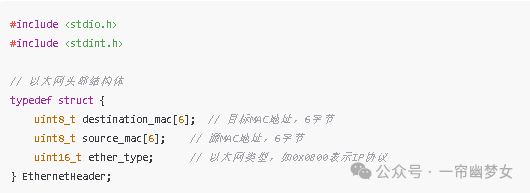1. Related to MAC Frame (Simple Simulation to Build MAC Frame)
-
Ethernet Header Structure Definition (C Language)
-

#include <stdio.h>
#include <stdint.h>
// Ethernet header structure
typedef struct {
uint8_t destination_mac[6]; // Destination MAC address, 6 bytes
uint8_t source_mac[6]; // Source MAC address, 6 bytes
uint16_t ether_type; // Ethernet type, e.g., 0x0800 indicates IP protocol
} EthernetHeader;-
Build a Simple MAC Frame Data (Fill Example Data)
#include <string.h>
// Fill MAC frame data
void build_mac_frame(EthernetHeader *eth_header) {
// Simple example MAC address filling (should be obtained from network interface in actual applications)
uint8_t dest_mac[6] = {0x00, 0x11, 0x22, 0x33, 0x44, 0x55};
uint8_t src_mac[6] = {0xAA, 0xBB, 0xCC, 0xDD, 0xEE, 0xFF};
memcpy(eth_header->destination_mac, dest_mac, 6);
memcpy(eth_header->source_mac, src_mac, 6);
eth_header->ether_type = 0x0800;
}2. Related to ARP Protocol (Simple ARP Request Sending Example, C Language)
-
ARP Header Structure Definition
// ARP header structure
typedef struct {
uint16_t hardware_type; // Hardware type, e.g., 1 for Ethernet
uint16_t protocol_type; // Protocol type, e.g., 0x0800 for IP
uint8_t hardware_size; // Hardware address length, 6 bytes for Ethernet MAC address
uint8_t protocol_size; // Protocol address length, 4 bytes for IPv4
uint16_t opcode; // ARP opcode, 1 for request, 2 for reply
uint8_t sender_mac[6]; // Sender MAC address
uint8_t sender_ip[4]; // Sender IP address
uint8_t target_mac[6]; // Target MAC address (usually all 0 in requests)
uint8_t target_ip[4]; // Target IP address
} ARPPacket;-
Send ARP Request (Simplified Example, More Error Handling Needed in Actual Use)
#include <sys/socket.h>
#include <linux/if_ether.h>
#include <linux/if_packet.h>
#include <arpa/inet.h>
// Function to send ARP request
void send_arp_request(int sockfd, const char *iface, const char *sender_ip_str, const char *target_ip_str) {
struct sockaddr_ll sa;
ARPPacket arp_packet;
// Initialize ARP packet content (some detailed settings omitted here)
arp_packet.hardware_type = htons(1);
arp_packet.protocol_type = htons(0x0800);
arp_packet.hardware_size = 6;
arp_packet.protocol_size = 4;
arp_packet.opcode = htons(1);
// Get local MAC address (simplified, should be obtained from interface)
uint8_t local_mac[6] = {0x00, 0x11, 0x22, 0x33, 0x44, 0x55};
memcpy(arp_packet.sender_mac, local_mac, 6);
inet_pton(AF_INET, sender_ip_str, arp_packet.sender_ip);
memset(arp_packet.target_mac, 0, 6);
inet_pton(AF_INET, target_ip_str, arp_packet.target_ip);
// Create socket
sockfd = socket(PF_PACKET, SOCK_RAW, htons(ETH_P_ARP));
if (sockfd < 0) {
perror("socket");
return;
}
// Set socket address structure
memset(&sa, 0, sizeof(sa));
sa.sll_family = AF_PACKET;
sa.sll_protocol = htons(ETH_P_ARP);
sa.sll_ifindex = if_nametoindex(iface);
// Send ARP request packet
sendto(sockfd, &arp_packet, sizeof(arp_packet), 0, (struct sockaddr *)&sa, sizeof(sa));
close(sockfd);
}These codes are just simple examples; in actual network programming applications, more error handling, network interface operations, and adherence to relevant protocol specifications and security requirements are needed.